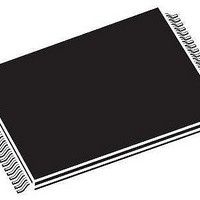M29W320DT70N6 STMicroelectronics, M29W320DT70N6 Datasheet - Page 40

M29W320DT70N6
Manufacturer Part Number
M29W320DT70N6
Description
Flash 4Mx8 or 2Mx16 70ns
Manufacturer
STMicroelectronics
Datasheet
1.M29W320DT70N6.pdf
(46 pages)
Specifications of M29W320DT70N6
Data Bus Width
8 bit, 16 bit
Memory Type
NOR Flash
Memory Size
32 Mbit
Architecture
Sectored
Interface Type
CFI
Access Time
70 ns
Supply Voltage (max)
3.6 V
Supply Voltage (min)
2.7 V
Maximum Operating Current
10 mA
Operating Temperature
+ 85 C
Mounting Style
SMD/SMT
Package / Case
TSOP-1-48
Organization
4 MB x 8
Lead Free Status / Rohs Status
Details
Available stocks
Company
Part Number
Manufacturer
Quantity
Price
Company:
Part Number:
M29W320DT70N6
Manufacturer:
ST
Quantity:
3 000
Company:
Part Number:
M29W320DT70N6
Manufacturer:
ST
Quantity:
3 000
Part Number:
M29W320DT70N6
Manufacturer:
ST
Quantity:
20 000
Company:
Part Number:
M29W320DT70N6
Manufacturer:
ST
Quantity:
12 103
Company:
Part Number:
M29W320DT70N6E
Manufacturer:
ST
Quantity:
1 500
Company:
Part Number:
M29W320DT70N6E
Manufacturer:
ST
Quantity:
3 198
Company:
Part Number:
M29W320DT70N6E
Manufacturer:
ST
Quantity:
3 198
Part Number:
M29W320DT70N6E
Manufacturer:
MICRON/ST
Quantity:
20 000
M29W320DT, M29W320DB
APPENDIX C. BLOCK PROTECTION
Block protection can be used to prevent any oper-
ation from modifying the data stored in the Flash.
Each Block can be protected individually. Once
protected, Program and Erase operations on the
block fail to change the data.
There are three techniques that can be used to
control Block Protection, these are the Program-
mer technique, the In-System technique and Tem-
porary Unprotection. Temporary Unprotection is
controlled by the Reset/Block Temporary Unpro-
tection pin, RP; this is described in the Signal De-
scriptions section.
Unlike the Command Interface of the Program/
Erase Controller, the techniques for protecting and
unprotecting blocks change between different
Flash memory suppliers. For example, the tech-
niques for AMD parts will not work on STMicro-
electronics parts. Care should be taken when
changing drivers for one part to work on another.
Programmer Technique
The Programmer technique uses high (V
age levels on some of the bus pins. These cannot
be achieved using a standard microprocessor bus,
therefore the technique is recommended only for
use in Programming Equipment.
To protect a block follow the flowchart in Figure
Figure 21., Programmer Equipment Block Protect
Flowchart. To unprotect the whole chip it is neces-
sary to protect all of the blocks first, then all blocks
can be unprotected at the same time. To unprotect
the chip follow Figure Figure 22., Programmer
Equipment Chip Unprotect Flowchart. Table 27.,
Table 27. Programmer Technique Bus Operations, BYTE = V
40/46
Block Protect
Chip Unprotect
Block Protection
Verify
Block Unprotection
Verify
Operation
V
V
V
V
E
ID
IL
IL
IL
V
V
V
V
G
ID
ID
IL
IL
V
V
IL
IL
V
V
W
Pulse
Pulse
IH
IH
ID
A0 = V
A0 = V
) volt-
A9 = V
A9 = V
IL
IL
A12-A20 Block Address
A12-A20 Block Address
, A1 = V
, A1 = V
ID
ID
Address Inputs
, A12-A20 Block Address
, A12 = V
Programmer Technique Bus Operations, gives a
summary of each operation.
The timing on these flowcharts is critical. Care
should be taken to ensure that, where a pause is
specified, it is followed as closely as possible. Do
not abort the procedure before reaching the end.
Chip Unprotect can take several seconds and a
user message should be provided to show that the
operation is progressing.
In-System Technique
The In-System technique requires a high voltage
level on the Reset/Blocks Temporary Unprotect
pin, RP. This can be achieved without violating the
maximum ratings of the components on the micro-
processor bus, therefore this technique is suitable
for use after the Flash has been fitted to the sys-
tem.
To protect a block follow the flowchart in Figure
Figure 23., In-System Block Protect Flowchart. To
unprotect the whole chip it is necessary to protect
all of the blocks first, then all the blocks can be un-
protected at the same time. To unprotect the chip
follow Figure Figure 24., In-System Chip Unpro-
tect Flowchart.
The timing on these flowcharts is critical. Care
should be taken to ensure that, where a pause is
specified, it is followed as closely as possible. Do
not allow the microprocessor to service interrupts
that will upset the timing and do not abort the pro-
cedure before reaching the end. Chip Unprotect
can take several seconds and a user message
should be provided to show that the operation is
progressing.
Others = X
Others = X
Others = X
Others = X
A0-A20
IH
IH
, A6 = V
, A6 = V
IH
, A15 = V
IH
IH
IL
or V
, A9 = V
, A9 = V
IL
IH
ID
ID
,
,
DQ15A–1, DQ14-DQ0
Data Inputs/Outputs
Retry = XX00h
Retry = XX01h
Pass = XX01h
Pass = XX00h
X
X













